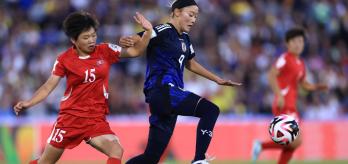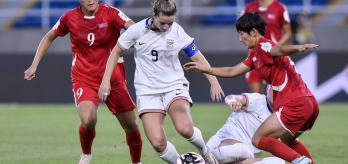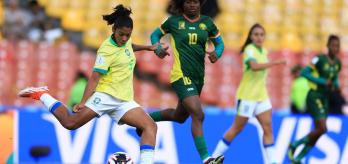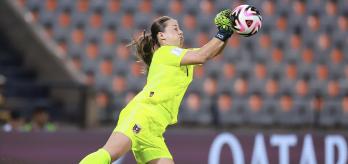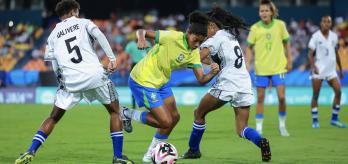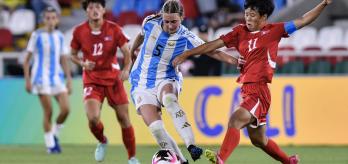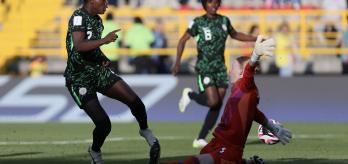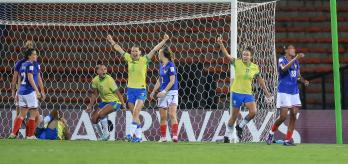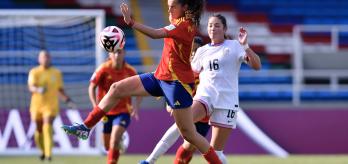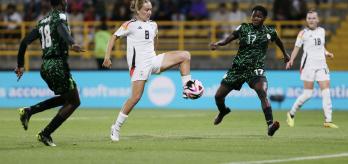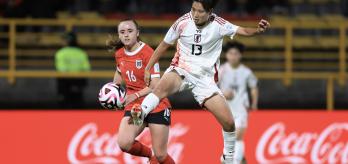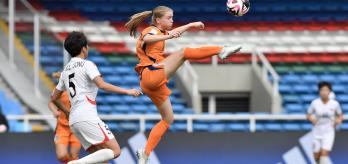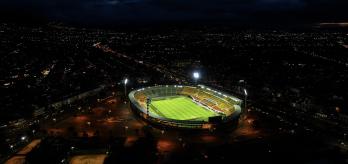This was a very tough group containing CONMEBOL Copa América Femenina winners Brazil, Canada, who finished in third place during the most recent Concacaf Women's U-20 Championship as well as UEFA European Women's Under-19 Championship semi-finalists, France. Meanwhile, Fiji had a difficult task ahead after qualifying for the FIFA U-20 Women’s World Cup™ for the very first time.
Brazil
In possession
Brazil are an attack-minded team using a 1-3-4-3 setup with the two wingers playing high and wide. They are patient when building from the goalkeeper with their three centre-backs very involved, particularly Rebeca (5) who often stepped in from her central centre-back position to create unexpected overloads in midfield and higher up the pitch. Once Brazil progressed the play into the middle of the pitch, their attacking tempo increased, using ball carries and fast, forward passes with runners looking to break lines and access the space in behind. All players are technically competent, meaning they can move the ball at speed and with great accuracy, making it very difficult for opposition defenders to stop them.
Out of possession
Brazil often started defensive phases in a high block position, with forwards and midfielders collectively pressing with the aim of winning the ball as close to their opponent’s goal as possible. When a high press was not feasible, they retreated to a compact, low block using a 1-5-4-1 shape, making it hard for opposition teams to play through them. During transitions to defend, they counter-pressed aggressively when it was appropriate and, individually, were very competent in 1v1 defending.
France
In possession
France have a very positive approach in their attacking play, using a 1-4-1-4-1 where Maëlle Seguin (6) acts as the pivot player, allowing other midfielders to play in more advanced positions, supporting the centre-forward, while width is maintained by their the wide midfielders. In build-up, they are direct and play forward early, looking to advance the ball from midfield to their centre-forward who likes to receive in front of the opposition’s defensive lines. If the centre of the pitch is closed off, France switch play to the wide areas where their full-backs and wingers look to support the attacks. Forward Dona Scannapieco (19) is very clever in her movement and can quickly turn defensive errors by opposing defenders into goalscoring opportunities.
Out of possession
They press opposition goal kicks from an organised 1-4-4-2 high block, applying direct pressure if their opponent’s make a mistake or play backwards in their build-up. During transitions to defend, France apply an aggressive counter-press to regain possession as quickly as possible and have successfully converted counter-pressure into goalscoring opportunities.
Canada
In possession
Canada deployed a very dynamic and varied attacking style using a 1-4-2-3-1 shape.The front four players in the attacking roles are all fast, agile, technical and very competent in taking opposition defenders on 1v1. They also have a strong synergy and understanding between each other. From a patient build-up, they often look to play direct balls to forward players in the channel areas behind their opponent’s defensive line. Once in the final third, Canada like to play with minimum touches, except when running with the ball to take on players. From wide areas, they progress play using lofted crosses and cut-backs while their midfield and defensive lines step up, ensuring short distances between the units of their team shape.
Out of possession
When they do not have the ball, Canada showed a preference to defend from a mid-block but if they lost the ball in the final third, the compactness of their team shape meant they could counter-press. Players showed a clear understanding of their defensive roles, as well as a strong commitment to recovery and supporting each other.
Fiji
In possession
Fiji showed a positive attitude when attempting to build play, using forward and through passes to try break the opposition’s lines centrally. In the wide areas, they played longer passes for forwards and wide midfielders to run onto. When using their 1-4-2-3-1 shape in attack, Fiji were more successful at progressing the ball higher up the pitch and retaining possession.
Out of possession
Fiji’s choice of formation varied between a 1-4-5-1 and a 1-5-4-1 when defending in a low block as they looked to reduce spaces for their opponents to play through. A hard-working team, they maintained a compact shape and showed great mental strength and team spirit by never giving up even if the scoreline ran away from them. They will take great learnings from their participation in their first FIFA U-20 Women’s World Cup and the experience will stand to them as they continue in their development.






